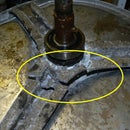Introduction: Laudable Laminate, Fearless Formica'ing or Countertop Replacement
This adventure in DIY started with a yardsale find of a kitchen island without a top. The island was a lot nicer than the contractor- grade island in our kitchen and much more accessible innards. After several trips to our favorite second-hand home improvement stores 50 miles on either end of our pennisula we were not able to find a piece of granite for less than $35/ square foot.Un-willing to drop $700-800 for a single countertop, my dedicated research assistant (Suzy Sledgehammer) sent for several samples of laminate and we decided on Golden Mascarelo from Formica. We ordered a piece directly through one the the big box stores. A little research and some supplies and this turned out to be a very easy project. You can do it!
Step 1: Supplies, Tools, and Protective Equipment
Some bare essentials for this project:
Tools:
Router and bit to trim the edges (I used my Bosch but it was a little oversized for this job.)
Circular saw with 40-80 teeth or greater
hand file approx. #40
paint brush (to spread the adhesive)
J-roller (or similar roller for pressing down hard on flat surfaces)
Pencil Compass (for curve drawing)
Straight edge/ yard stick
Tape Measure
Compass (geometric drawing style)
Material and Consumables:
Contact Cement/Structural Adhesive (coat parts to be glued together; let it dry to touch; press together; Roller press down hard)
Foam board approx 1/2" thick (sacrificial surface for cutting the laminate with a circular saw)
Particleboard, composite wood-board or plywood
Dowels, longer than your counter is wide. I used bamboo from our gardening supplies
Sanding block or paper
Acetone
Drop Cloth (Glue spills are not fun to clean off floors)
Masking Tape (great for clean caulk lines, protecting edges, stopping splintering, ball for your cat to bat around, multiple uses)
Personal Protective Equipment:
Eyewear
Ear plugs/muffs
disposable gloves
dust mask (for sanding and minor adhesive fumes)
Step 2: Cutting the Rounded Corners
Depending on the corner radius you desire and the thickness of the laminate, you can put a nice curved corner on the top. (See the pic for how to.) Be sure to keep the curve vertical and flat in order to have a good surface to glue your laminate to.
If your laminate feels like it may break when you try to bend it to the curve you can: (a) heat the laminate from the backside using a heatgun or hairdryer. (b) sand the backside of the laminate SLOWLY reducing the thickness enough to to flex to the curve without breaking.
Step 3: Sides First
Measure and cut your laminate with a circular saw set to one tooth thickness below the laminate. Lay the laminate on top of your foam board to increase its surface tension which keeps it flat as your saw cuts and prevents the laminate from splintering.
Adhesive is applied thin and evenly to both the Formica/laminate and the vertical sides of the counter, wait about 15- 20 minutes (in a 75 degree room) or dry to touch. Use a piece of wax paper if you don't want to stick a finger to it.
Start at the center of the strip and work your way towards the ends. This is when the clamps become useful if you don't have a helper because you can hold the strip loosely near the position, then press HARD with the roller to get rid of bubbles. You will very likely have some overhang on one side or both. This is the routers job to clean up, running along the edge using the particleboard to guide the bearing bit. (Take your time and let the tool do the work, working at a steady pace in one direction only.)
Routers are loud and messy, so take appropriate eye and ear protective measures.
Step 4: Tops and Finishing Touches
If you decide to not remove the old laminate surface, make sure it is very clean, free of oil and dirt. I used an ammonia based cleaner then a final light wipe with acetone and let it dry for a minute. Keep the work area well ventilated, the chemical fumes can sneak up on you. (Never x3 use Ammonia and Chlorine Bleach together to clean, it produces poisonous fumes/gases)
For large areas like my kitchen island, I use the dowels to keep the Formica off the the adhesive but close enough to tell if if it is positioned correctly. Working from the center, pull a dowel, press down hard with the roller, and pull the next dowel, roller, repeat... working your way out to the ends.
Router time again. The bearing guide will keep the bit from into your side laminate as long you keep it perpendicular to that surface.
For areas that are backsplashes, you can seal the seams with colored caulking. It gives it a very professional and finished appearance.
Step 5: Clean Up and Smile!
Clean up is easy with a vacuum. Once the laminate is roller pressed into positon it is not going anywhere! Use your normal cleaning fluids for dust and grime.
If you accidently get the adhesive on something you didn't intend, an acetone dampened cloth will remove. (Don't forget rubber/ disposable gloves!)
Thanks for checking this out. Feel free to critque and ask questions
-Kuhldad
**(Disclaimer: no Norwegian Forest cats were part in this project and any involvement was strictly in a consultation role. Mostly they laid in the middle of drop clothes and supervised. Masking tape balls were only entertaining until they were batted under a cabinet out of reach.)**

Participated in the
Furniture Contest













